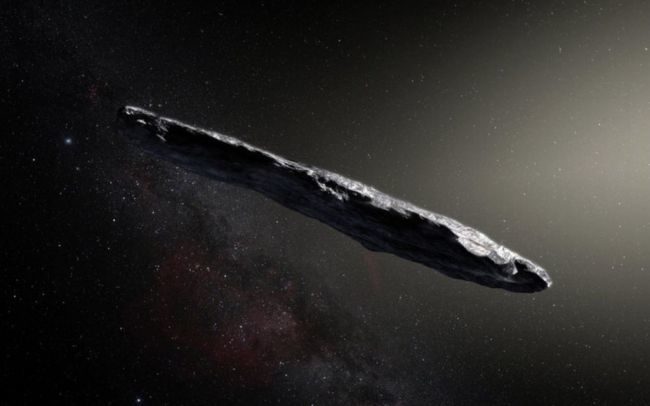
That visitor is 'Oumuamua, which zoomed through Earth's neighborhood in the fall of 2017 and is now streaking toward the dark depths of the outer solar system. The interloper puzzled researchers shortly after its detection, and the air of mystery surrounding the object hasn't dissipated.
'Oumuamua's oddness is multilayered. For starters, it seems to be cigar- or pancake-shaped, which is definitely not the norm for space rocks that astronomers are familiar with.
'Oumuamua also displayed non-gravitational acceleration, movement not caused by the tug of the sun or any other big cosmic object. Comets frequently display such movement as they heat up and begin spouting jets, but 'Oumuamua never sported a cometary tail or coma, as far as researchers could tell.
Finally, spotting 'Oumuamua in the first place is a bit strange, considering how huge space is and how incomplete our search for such bodies has been to date. The detection implies that the population of 'Oumuamua-like objects out there is enormous — unless the visitor targeted our system somehow.
And there has indeed been some speculation that 'Oumuamua could be an alien spacecraft. Avi Loeb, the chair of Harvard University's astronomy department, has suggested the visitor may be a solar-sailing probe, perhaps a defunct one. We should at least keep our minds open to the possibility, Loeb has stressed.
The new study doesn't invoke aliens, but it nonetheless makes the case that 'Oumuamua is pretty special.
"We show that it was likely composed of hydrogen ice," study co-author Greg Laughlin, a professor of astronomy at Yale University in Connecticut, said in a statement. "This is a new type of object, but it looks like there may be many more of them showing up going forward."
Hydrogen is the most abundant element in the universe, but we don't often see it in solid form; that requires extremely cold temperatures. But such temperatures exist in the coldest cores of giant molecular clouds, nurseries that give rise to stars and their associated planetary systems, said Laughlin and lead author Daryl Seligman, who was a Yale grad student but is now at the University of Chicago.
The duo's modeling work suggests that bodies rich in hydrogen ice could form in these cores — and that such bodies would behave much as 'Oumuamua did when it cruised through the inner solar system.
"As 'Oumuamua passed close to the sun and received its warmth, melting hydrogen would have rapidly boiled off the icy surface, providing the observed acceleration and also winnowing 'Oumuamua down to its weird, elongated shape — much as a bar of soap becomes a thin sliver after many uses in the shower," Laughlin said.
If he and Seligman are right, such "hydrogen comets" should be quite common, and studying them could shed light on star and planet formation.
"Their presence would be an accurate probe of the conditions in the dark recesses of star-forming clouds and provide a critical new clue for understanding the earliest phases of the still-mysterious processes that generate the birth of stars and their accompanying planets," Laughlin said.
The new study has been accepted for publication in The Astrophysical Journal Letters. You can read a preprint of it for free at arXiv.org.
The new study is not the last word on 'Oumuamua; there are other potential explanations for its weirdness. There's the alien idea, for example, and a recently advanced hypothesis that 'Oumuamua is a fragment of a larger body that was torn apart during a close flyby of its native star.
'Oumuamua has long since passed out of astronomers' sight. But scientists are hopeful of seeing many more objects like it in the near future, especially after the Vera C. Rubin Observatory gets up and running in Chile.
And the interstellar-visitor count now stands at two, after the detection of an object known as Comet Borisov in August 2019. Borisov is not as odd as 'Oumuamua; it is quite recognizably a comet.



Reader Comments
The Real Crisis in Cosmology - The Big Bang Never Happened - [Link]
The Real Crisis in Cosmology - The Galactic Origin of Light Elements - [Link]